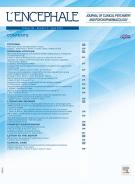Hallucination négative, conscience de soi et avancée en âge - 22/04/15
 , F. Stephan c, d, M. Walter b, c, d, P. Thomas e
, F. Stephan c, d, M. Walter b, c, d, P. Thomas e| pages | 6 |
| Iconographies | 0 |
| Vidéos | 0 |
| Autres | 0 |
Résumé |
Nous proposons dans cet article de faire le point sur les hallucinations négatives chez la personne âgée et sa prise en charge. La phénoménologie des hallucinations négatives est riche d’informations sur l’origine des symptômes psychotiques aux âges tardifs. Les relations entre hallucinations, troubles de l’humeur, et symptômes négatifs sont souvent difficiles d’appréhension par les soignants et mal vécues par les proches. L’identification des manifestations hallucinatoires nécessite une approche rigoureuse, d’autant plus indispensable qu’existe une très grande hétérogénéité des tableaux cliniques, notamment dans le syndrome de Cotard. Si l’hallucination négative a une fonction anti-traumatique pour le Moi de la personne âgée dans sa lutte contre la souffrance psychique, elle n’en témoigne pas moins d’une insuffisance de symbolisation. La prévalence de ce symptôme est sans doute sous-estimée, bien que sa présence indique souvent une atteinte thymique plus marquée. Ces symptômes hallucinatoires ont un retentissement important dans la vie relationnelle des malades, qui apparaissent prisonniers d’une souffrance incommunicable. Les thérapeutiques médicamenteuses ne sont pas toujours efficaces. Le traitement se doit donc de privilégier le rapport au corps dans une visée énergique, et ainsi proposer des approches non médicamenteuses, somatiques, invasives (ECT) ou non (SMTr).
Le texte complet de cet article est disponible en PDF.Summary |
Background |
Negative hallucinations are characterized by a defect in perception of an object or a person, or a denial of the existence of their perception. Negative hallucinations create blank spaces, due to both an impossible representation and an incapability of investment in reality. They have a close relationship with Cotard's syndrome, delusional theme of organ denial observed in melancholic syndromes in the elderly.
Methods |
Phenomenological approach. The phenomenology of negative hallucinations provides quite an amount of information on the origin of the psychotic symptoms when one is rather old.
Results |
The connections between hallucinations, mood disorders and negative symptoms are often difficult to live with for the nearest and dearest. Negative hallucinations require a strict approach to identify their expression that is crucial because a wide heterogeneity exists within the pathological pictures, as in Cotard's syndrome. Although the negative hallucination has an anti traumatic function in elderly people fighting against mental pain, it still represents a deficiency in symbolization. The prevalence of this symptom is without doubt underestimated, although its presence often underlines thymic suffering that is more striking. These hallucinatory symptoms have an important impact on the patients’ daily life, and they appear to be prisoners of a suffering, which cannot be revealed.
Conclusions |
We propose in this article to review the clinical symptoms of negative hallucinations in the elderly and the way to manage them. The medicinal approaches are not always effective. A greater place must be given to what is in connection with the body, aiming at a strong impact and thus to offer non-pharmacological approaches, such as somatic ones, which can be either invasive (electroconvulsive therapy) or not (transcranial magnetic stimulation).
Le texte complet de cet article est disponible en PDF.Mots clés : Conscience de soi, Hypocondrie, Syndrome de Cotard, Hallucination négative, Mélancolie, Sujet âgé, SMTr
Keywords : Self consciousness, Hypochondria, Cotard's syndrome, Negative hallucination, Melancholia, Elderly, SMTr
Plan
Vol 41 - N° 2
P. 168-173 - avril 2015 Retour au numéroBienvenue sur EM-consulte, la référence des professionnels de santé.
L’accès au texte intégral de cet article nécessite un abonnement.
Bienvenue sur EM-consulte, la référence des professionnels de santé.
L’achat d’article à l’unité est indisponible à l’heure actuelle.
Déjà abonné à cette revue ?

